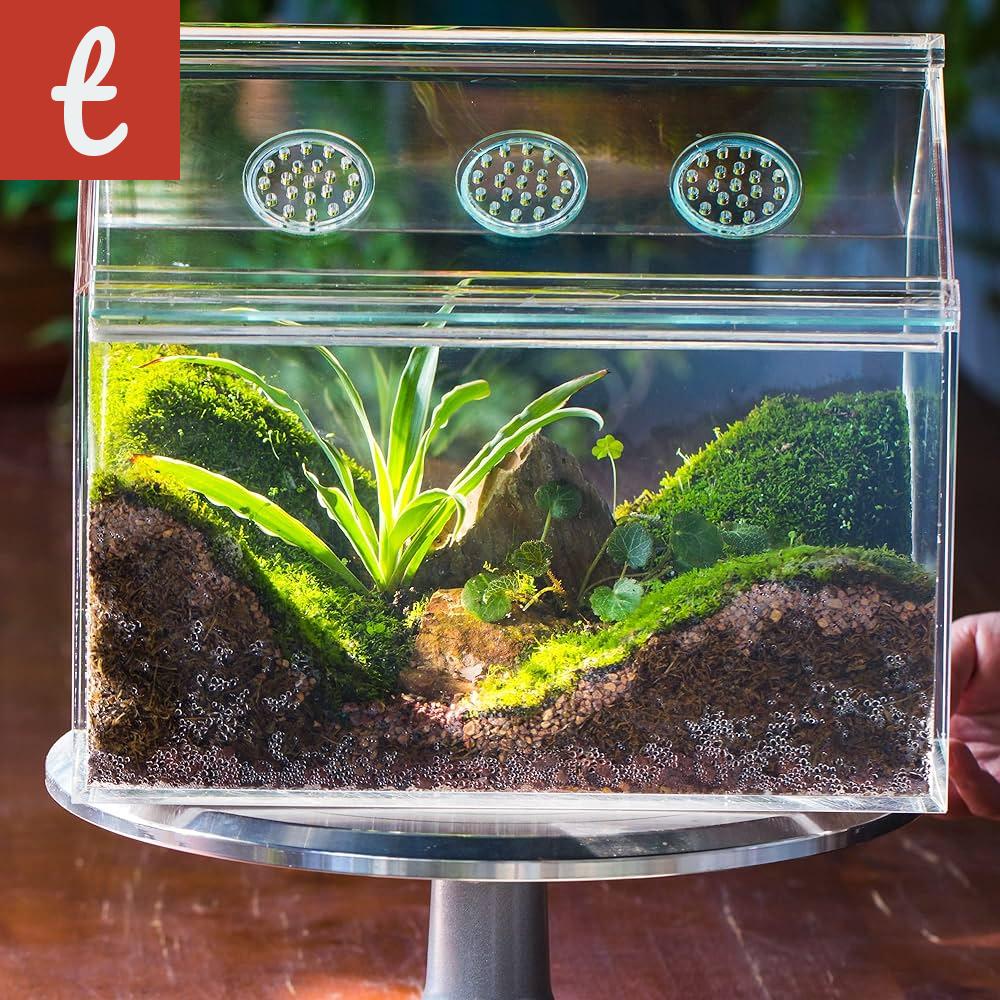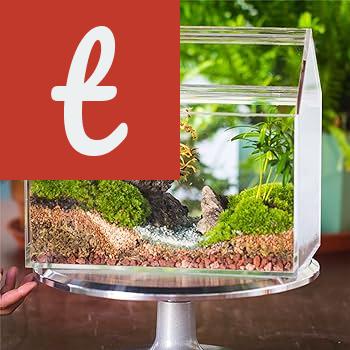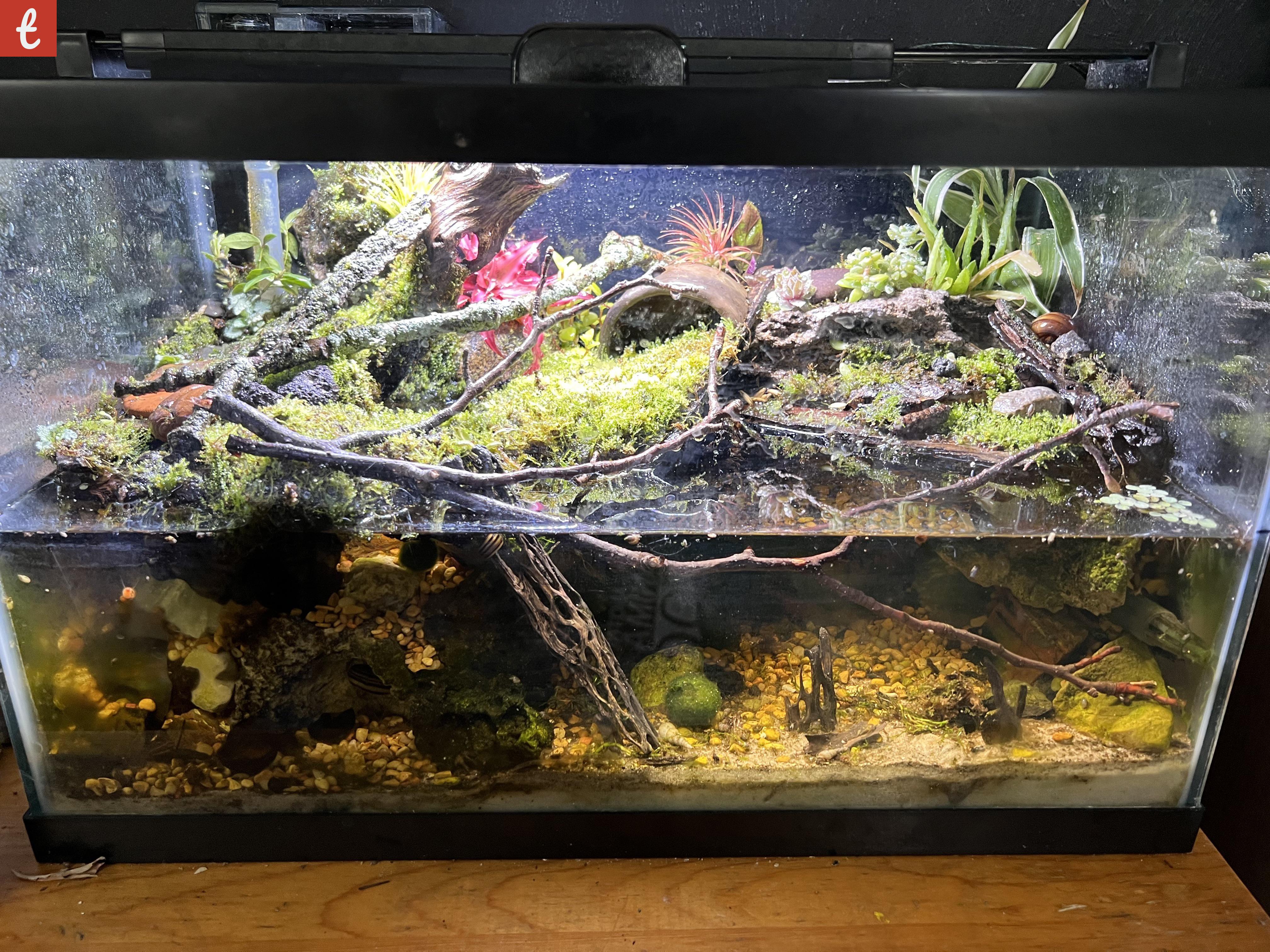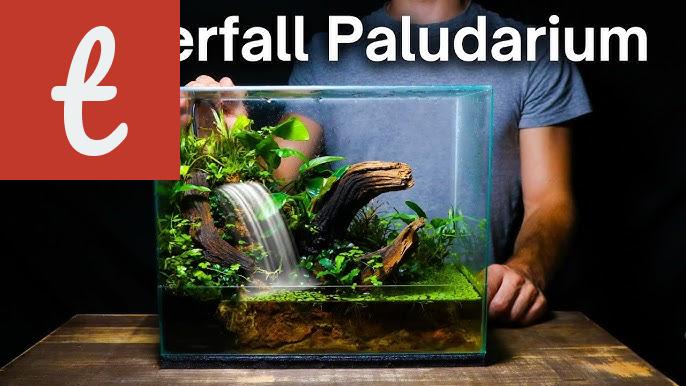Creating Miniature Paludariums: A Guide to Tiny Aquatic Habitats
Are you looking for a unique and captivating way to bring the beauty of aquatic life into your home or office? Look no further than miniature paludariums! These tiny aquatic habitats combine the enchantment of a tropical rainforest with the tranquility of a freshwater aquarium. In this guide, we will explore the art of creating and maintaining these captivating miniature ecosystems.
Miniature paludariums are a combination of a terrarium, designed for land-dwelling plants, and an aquarium, designed for aquatic life. These sustainable ecosystems allow you to house both aquatic plants and small aquatic animals such as fish, shrimp, or amphibians in a compact yet visually stunning environment.
- Research and Planning: Before diving into the process of creating a miniature paludarium, it is essential to gather information and plan accordingly. Decide on the size, shape, and location of your paludarium. Consider the type of plants and animals you want to incorporate.
- Choosing the Right Enclosure: The enclosure is a crucial element of your miniature paludarium. Opt for a glass tank or terrarium with a secure lid to maintain humidity levels. Ensure the enclosure has proper ventilation and drainage to prevent waterlogging.
Now that you have your enclosure ready, it's time to assemble the elements of your miniature paludarium:
1. Substrate: Begin by adding a layer of substrate at the bottom of the enclosure. Use a combination of organic soil, peat moss, and sand to create a suitable base for plant roots. This substrate will provide essential nutrients for your plants to thrive.
2. Hardscape: Introduce decorative elements such as rocks, driftwood, or branches to create a natural ambiance. These elements not only enhance the aesthetic appeal but also serve as climbing surfaces for your plants or hiding spots for your aquatic inhabitants.
3. Water: Now, it's time to add water to your paludarium. Fill the tank partially with dechlorinated water, leaving enough space for your aquatic animals to swim comfortably without submerging the entire plant area.
4. Plant Selection: Choose plant species that thrive in both aquatic and terrestrial environments. Popular choices include mosses, ferns, and tropical plants like Fittonia or Pothos. Arrange the plants based on their height and water requirements, ensuring a visually appealing and harmonious composition.
5. Aquatic Life: Depending on the size of your paludarium, you can introduce small fish, shrimp, or even frogs or newts. Ensure you research and choose species that can thrive in the specific conditions you have created.
Once your miniature paludarium is set up, proper maintenance is necessary to ensure the health and longevity of the ecosystem:
- Lighting: Place your paludarium in an area with indirect sunlight or use artificial lights to provide the necessary illumination for plant growth.
- Temperature and Humidity: Monitor the temperature and humidity levels in your paludarium. Use a thermometer and hygrometer to maintain the ideal conditions for both plants and animals.
- Water Care: Regularly check the water quality and perform partial water changes to keep the environment clean and free from harmful substances.
In conclusion, creating miniature paludariums is an immersive and rewarding hobby that allows you to enjoy the beauty of aquatic life in a confined space. By following the steps outlined in this guide and providing proper care and maintenance, you can create a captivating miniature ecosystem that will be admired by friends, family, and anyone who appreciates the wonders of nature.
Exploring the World of Miniature Paludariums: An Aquatic Haven in a Small Space
Have you ever dreamed of creating your own little oasis of nature in a limited space? Look no further than miniature paludariums – the perfect solution for bringing a slice of the aquatic world into your home or office. These compact and self-contained ecosystems combine elements of both aquariums and terrariums, allowing you to enjoy the beauty of aquatic life while showcasing lush, tropical plants – all within a small, easily manageable environment.
Miniature paludariums have gained significant popularity in recent years due to their versatility and aesthetic appeal. Whether you're an experienced aquarist or a complete newbie, these miniaturized aquatic habitats offer a fantastic opportunity to explore and nurture a diverse range of aquatic plants, mosses, amphibians, or even small fish species.
- Designing Your Miniature Aquatic Haven
The first step in creating a miniature paludarium is careful planning and design. Consider the available space, the desired level of complexity, and the species of plants and animals you intend to keep. Remember, balance is key – the size of your paludarium should match the living requirements of the inhabitants you wish to keep.
When it comes to the design, you have an array of choices. Some enthusiasts prefer to create a more naturalistic look, mimicking specific biotopes such as rainforests or wetlands. Others opt for a stunning underwater landscape with carefully selected plants, rocks, and driftwood. The possibilities are endless, limited only by your imagination.
- Essential Equipment and Maintenance
Once you have your design in mind, it's time to get the necessary equipment. A miniature paludarium typically consists of three main components: a water-filled tank, a land area, and appropriate lighting systems. The water section should be equipped with a filtration system to maintain water quality and oxygenate the aquatic environment.
Choosing the right lighting system is crucial for the healthy growth of plants and the overall success of your mini aquatic haven. Low to medium light plants often thrive in paludariums, such as anubias, crypts, and mosses. Additionally, consider the use of timers to maintain a natural day and night cycle for both the aquatic and land sections.
- Caring for Your Miniature Paludarium
Maintaining a miniature paludarium is relatively straightforward. Regular monitoring of water parameters, such as temperature, pH, and ammonia levels, is necessary to ensure the well-being of your aquatic inhabitants. Water changes and filter cleanings are essential to prevent the buildup of harmful substances and maintain a balanced ecosystem.
When it comes to the land area of your paludarium, remember to water the plants regularly to keep them healthy and thriving. Adjust the humidity levels to suit the specific plant species you have chosen. Pruning and trimming may be required to prevent overgrowth and maintain the desired aesthetic appeal.
With the right care and attention, your miniature paludarium can become a striking centerpiece and a tranquil haven in any space, be it an office desk or a small apartment. So, why not unleash your creativity and embark on a journey into the captivating world of miniature aquascaping?
The Fascinating World of Miniature Paludariums: Introducing Aquatic Life to Small Spaces
Are you looking to bring a touch of nature into your small living space? Miniature paludariums might just be the answer. These fascinating miniature ecosystems combine the beauty of an aquarium with the lushness of a terrarium, offering a unique and captivating way to introduce aquatic life to limited spaces.
Paludariums are essentially glass enclosures that accommodate both aquatic and terrestrial plants alongside small aquatic animals like fish, shrimp, and even frogs. They provide a compact and self-contained habitat that allows you to immerse yourself in the wonders of nature, no matter how limited your living space may be.
- List item 1: Miniature paludariums offer a stunning visual display, making them an attractive addition to any home or office environment. The combination of vibrant aquatic plants, unique land features, and floating moss create a mesmerizing sight that can captivate viewers for hours.
- List item 2: The miniaturization of the paludariums also means that they require minimal upkeep. With a smaller water volume, maintenance tasks such as water changes and cleaning are much simpler compared to traditional aquariums. This makes them an ideal choice for busy individuals who still want to experience the joy of keeping and observing aquatic life.
Adding to their appeal, miniature paludariums allow you to experiment and create your own unique world within the glass enclosure. By carefully selecting different plant species, rocks, driftwood, and other decorative elements, you can design a paludarium that reflects your personal taste and style.
Furthermore, miniaturized aquatic ecosystems offer an educational aspect to enthusiasts of all ages. They provide an opportunity to learn about the delicate balance of nature, the importance of proper water chemistry, and the intricacies of plant and animal interactions.
If you're considering setting up a miniature paludarium, it's important to research and select appropriate plant and animal species that can thrive in a smaller environment. With the right choices, you can create a self-sustaining mini-ecosystem that requires minimal intervention.
In conclusion, miniature paludariums provide a captivating way to bring the beauty of aquatic life into small spaces. With their stunning visual appeal, low maintenance requirements, and educational value, they offer a unique combination of artistry and biology. So, why not venture into the fascinating world of miniature paludariums and create your own miniature wonderland?

Miniature Paludariums: Transforming Small Areas into Aquatic Paradises
Are you looking to infuse some greenery into your home or office space? Consider creating a miniature paludarium. Not only will it add a touch of nature to your surroundings, but it will also provide a serene and calming environment for you to enjoy.
A paludarium is a unique combination of an aquarium and a terrarium. Unlike traditional aquariums that only house aquatic life, paludariums incorporate both aquatic and terrestrial plants into their design. This creates a harmonious ecosystem within a confined space, allowing you to observe the interactions between plants and animals.
- Benefits of Miniature Paludariums
1. Space-saving: One of the main advantages of miniature paludariums is their size. Perfect for small apartments or offices with limited space, these compact setups can fit on a desk or a shelf while still providing a stunning display of nature.
2. Low maintenance: Miniature paludariums are relatively easy to maintain compared to larger aquariums. With a smaller volume of water and fewer plants and animals, you can easily monitor and manage the environment for optimum conditions.
3. Air quality improvement: The combination of terrestrial plants and water in a paludarium promotes better air quality. Plants naturally purify the air by absorbing carbon dioxide and releasing oxygen, creating a healthier space for you to breathe.
- Creating Your Own Miniature Paludarium
1. Choose the right container: Select a glass or acrylic container that is suitable for holding water. Ensure that it has a secure lid to maintain humidity levels and prevent escape of plants or animals.
2. Create the water area: Fill the bottom of the container with a layer of aquarium-safe gravel or pebbles. Add enough water to create a small aquatic area for freshwater fish or aquatic invertebrates to thrive.
3. Set up the land area: Build up a substrate layer using a mix of soil and sand. This will provide a solid foundation for your plants to grow. You can also add rocks, logs, or small branches to create a natural-looking landscape.
4. Choose appropriate plants: Select a variety of aquatic and terrestrial plants that thrive in similar conditions. Consider plants like ferns, mosses, and small tropical plants that can tolerate high humidity levels.
5. Introduce suitable animals: Carefully choose small fish or aquatic invertebrates that are compatible with the plant life and water conditions. Ensure that the animals have enough space to swim or move around comfortably.
6. Maintain the ecosystem: Regularly monitor and maintain the water temperature, humidity levels, and lighting conditions. Trim or prune the plants as needed and keep an eye out for any signs of disease or pests.
Whether you are a seasoned aquarist or a plant enthusiast, creating a miniature paludarium is an exciting and rewarding project. Not only will you have a visually stunning piece of nature in your space, but you will also be able to witness the delicate balance of life flourishing within the confined walls of your mini oasis.
Unleashing Creativity with Miniature Paludariums: Tiny Homes for Aquatic Life
In the world of aquascaping, miniature paludariums are gaining popularity for their unique and captivating appeal. These tiny ecosystems allow you to combine aquatic life, plants, and natural elements to create a stunning display that showcases the beauty of nature. It's like having your own tiny world right at your fingertips.
But what exactly is a paludarium?
A paludarium is a specialized type of vivarium that combines both an aquatic and terrestrial environment. The word "paludarium" comes from the Latin word "palus," which means swamp or marsh. It is a habitat that supports both aquatic plants and animals, as well as land-dwelling plants and creatures.
These miniature paludariums provide a unique opportunity to experiment with different plants and aquatic life in a confined space. With the right combination of plants, rocks, driftwood, and additional elements, you can create a captivating display that resembles a slice of nature in your living room or office.
Why Choose Miniature Paludariums?
Miniature paludariums have several advantages over larger tanks or vivariums. Here are a few reasons why they are becoming a favorite among aquascaping enthusiasts:
- Space-Saving: Miniature paludariums take up less space compared to larger tanks. They are perfect for those who want to enjoy the beauty of aquatic life but have limited space.
- Creative Expression: These tiny habitats offer endless possibilities for creativity. From selecting the perfect plants to arranging rocks and other natural elements, you are only limited by your imagination.
- Low Maintenance: Miniature paludariums are relatively low maintenance compared to larger setups. With the right selection of plants and animals, they can be self-sustaining and require minimal care.
- Educational and Therapeutic: Observing and caring for a miniature paludarium can be a calming and educational experience. It offers a glimpse into the delicate balance of nature and can serve as a teaching tool for both children and adults.
Getting Started with Miniature Paludariums
Creating your own miniature paludarium is an exciting journey that allows you to express your creativity and showcase your passion for nature. Here are a few steps to get you started:
- Research: Before you dive into creating a paludarium, research different species of aquatic plants and animals that are suitable for a paludarium environment. Take into account their specific requirements for temperature, humidity, light, and water quality.
- Design: Decide on the size and shape of your paludarium. Consider the overall aesthetic you want to achieve and plan the arrangement of plants, rocks, and other elements.
- Materials: Gather the necessary materials, including the aquarium or terrarium, substrate, plants, rocks, driftwood, and any additional decorations you want to include.
- Assembly: Carefully set up your paludarium, taking into consideration the needs of your chosen plants and animals. Create the perfect balance of moisture, light, and temperature to ensure the success of your miniature ecosystem.
- Maintenance: Regular maintenance is crucial for the health and longevity of your paludarium. Monitor water parameters, trim plants as needed, and ensure proper cleaning of the tank to prevent the build-up of harmful bacteria.
Conclusion
Miniature paludariums are an excellent way to explore your creativity, unleash your inner aquascaper, and bring a touch of nature into your home or office. These tiny homes for aquatic life offer a unique opportunity to create a captivating and self-sustaining ecosystem that will leave you in awe. So go ahead, dive into the world of miniature paludariums, and embark on this enchanting journey of creating your own tiny world of aquatic wonders.




Comments on "Miniature Paludariums: Tiny Homes For Aquatic Life"
No comment found!